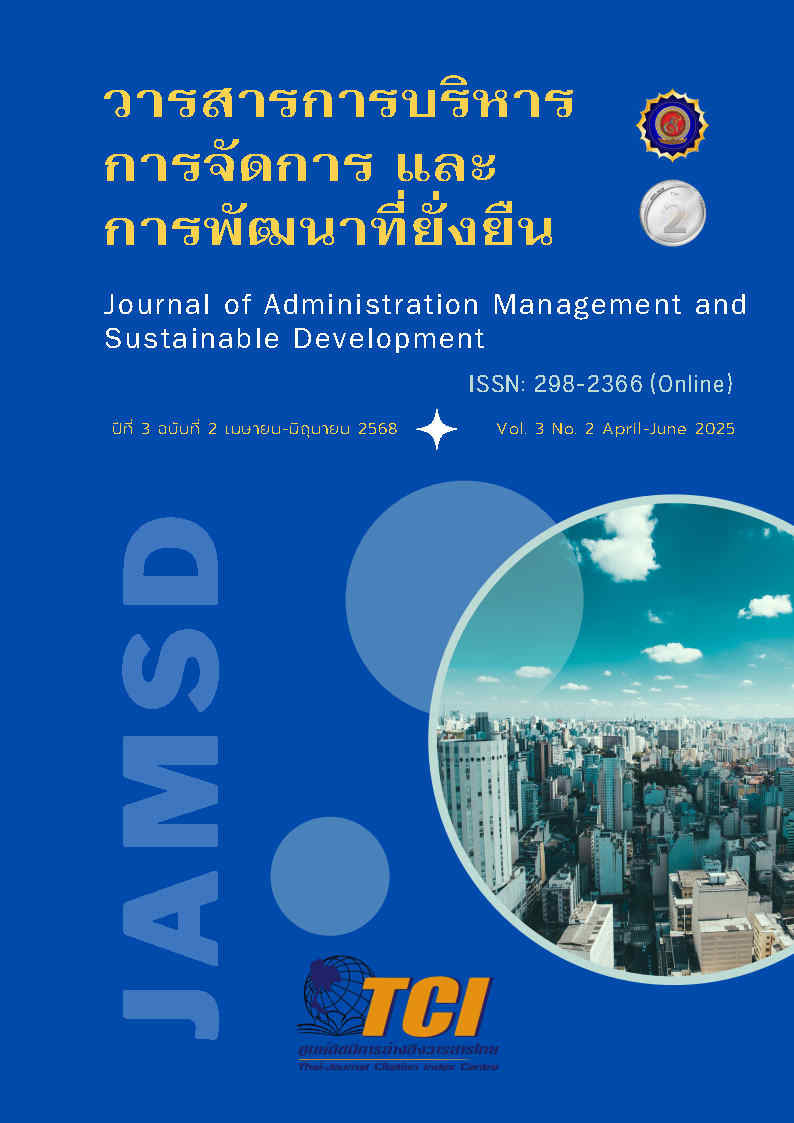Energy management and social innovation management affecting the energy saving efficiency of industrial plants in Amata City industrial estate, Chonburi Province
Keywords:
energy management, social innovation management, energy-saving effectivenessAbstract
This research aimed to 1. study energy management, social innovation management, and energy-saving effectiveness, and 2. study energy management and social innovation management affected energy-saving effectiveness. The population consisted of 700 industrial factories in Amata City Industrial Estate, Chonburi Province, using 248 samples. The respondents were senior executives, including general managers, deputy general managers, assistant general managers, or middle executives, including deputy heads of departments, directors, managers, or persons assigned by the establishments. The respondents were considered representatives of the units. The instruments used consisted of a 5-level rating scale questionnaire. The content validity was checked by 10 experts using the S-CVI (Scale Content Validity Index). The average CVI was 9.49, the S-CVI was 0.95, and the questionnaire reliability was over 0.9 for all items. Data were collected using a Google form. The statistics used in the research included percentage, mean, standard deviation, Pearson correlation, and multiple regression analysis. The findings revealed that the levels of energy management, social innovation management, and energy-saving effectiveness were all rated high, with innovation management exhibiting the highest mean score. Moreover, key components of energy management and social innovation management significantly influenced energy-saving effectiveness at the 0.05 statistical significance level, indicating that 83.7% of the variance in energy-saving effectiveness could be explained by these factors. Significant predictors included reconsideration of core concepts of social innovation, organizational knowledge integration through open and transparent communication, efficient energy planning and analysis, and the incorporation of social innovation into business activities. These findings offer strategic insights for enhancing the energy-saving performance of industrial factories by emphasizing innovation and systematic energy management practices.
References
สำนักงานปลัดกระทรวงพลังงาน. (2564). แผนปฏิบัติราชการ ราย 5 ปี พ.ศ.2566-2570 ของกระทรวงพลังงาน. กรุงเทพฯ: กระทรวงพลังงาน.
สำนักงานพัฒนาวิทยาศาสตร์และเทคโนโลยีแห่งชาติ (สวทช.). (2563). โมเดลเศรษฐกิจใหม่ BCG. กรุงเทพฯ: สำนักงานพัฒนาวิทยาศาสตร์และเทคโนโลยีแห่งชาติ.
AMATA. (2024). Energy management report. AMATA Corporation.
Chulalongkorn University. (2025). CU Social Innovation Hub: Research and impact. Retrieved 17 March 2025, from https://www.research.chula.ac.th/en/cu-social-innovation-hub/.
Díaz‐García, C., González‐Moreno, Á., & Sáez‐Martínez, F. J. (2015). Eco‐innovation: Insights from a literature review. Innovation, 17(1), 6–23. https://doi.org/10.1080/14479338.2015.1011060.
Glisson, C., & Williams, N. J. (2015). Assessing and changing organizational social contexts for effective mental health services. Annual Review of Public Health, 18(36), 507-523.
Hair, J. F., Black, W. C., Babin, B. J., & Anderson, R. E. (2019). Multivariate data analysis (8th ed.). Cengage Learning.
Howaldt, J., Kaletka, C., Schröder, A., & Zirngiebl, M. (2018). Atlas of social innovation – Practices for a better future. Sozialforschungsstelle Dortmund, TU Dortmund University.
International Organization for Standardization. (2018). ISO 50001:2018 – Energy management systems — Requirements with guidance for use. ISO. https://www.iso.org/standard/69426.html.
Klejwitz, J., Zeyen, A., & Hansen, E. G. (2012). Intermediaries driving eco-innovation in SMEs: A qualitative investigation. European Journal of Innovation Management, 15(4), 442–467.
Mulgan, G. (2019). Social innovation: How societies find the power to change. Policy Press.
Phillips, W., Lee, H., Ghobadian, A., O’Regan, N., & James, P. (2015). Social innovation and social entrepreneurship: A systematic review. Group & Organization Management, 40(3), 428–461.
Porter, M. E., & van der Linde, C. (1995). Toward a new conception of the environment-competitiveness relationship. Journal of Economic Perspectives, 9(4), 97–118. https://doi.org/10.1257/jep.9.4.97.
Richman, E. E. (2016). Measurement and verification of energy savings and performance from advanced lighting controls. Pacific Northwest National Laboratory. https://www.osti.gov/biblio/1244177.
Sherwin, E. D., Meyer, R. M., & Azevedo, I. M. L. (2022). Limitations of econometric evaluation of nonrandomized residential energy efficiency programs: A case study of Northern California rebate programs. Environmental Data Science, 1, e1. doi:10.1017/eds.2021.1.
Sioshansi, F. P. (Ed.). (2013). Energy efficiency: Towards the end of demand growth. Elsevier.
Siva, A. (2023). Total Energy Management: Reduce Energy Costs and Improve Profits. https://facilio.com/blog/total-energy-management/.
Sussman, R., & Chikumbo, O. (2016). Behavior changes programs: Status and impact. American Council for an Energy-Efficient Economy. https://www.aceee.org/research-report/b1601.
Thai-Koujyo. (2568). นิคมอุตสาหกรรมอมตะซิตี้ ชลบุรี. สืบค้น 17 มีนาคม 2568 จาก https://www.thai-koujyo.com/ ie_summary.php?lg=th&ineid=0004.
Thollander, P., & Palm, J. (2013). Improving energy efficiency in industrial energy systems: An interdisciplinary perspective on barriers, energy audits, programs, and policies. Springer. https://doi.org/10.1007/978-1-4471-4162-4.
Unceta, A., Luna, Á., Castro, J., & Wintjes, R. (2020). Social innovation regime: An integrated approach to measure social innovation. European Planning Studies, 28(5), 906-924.





